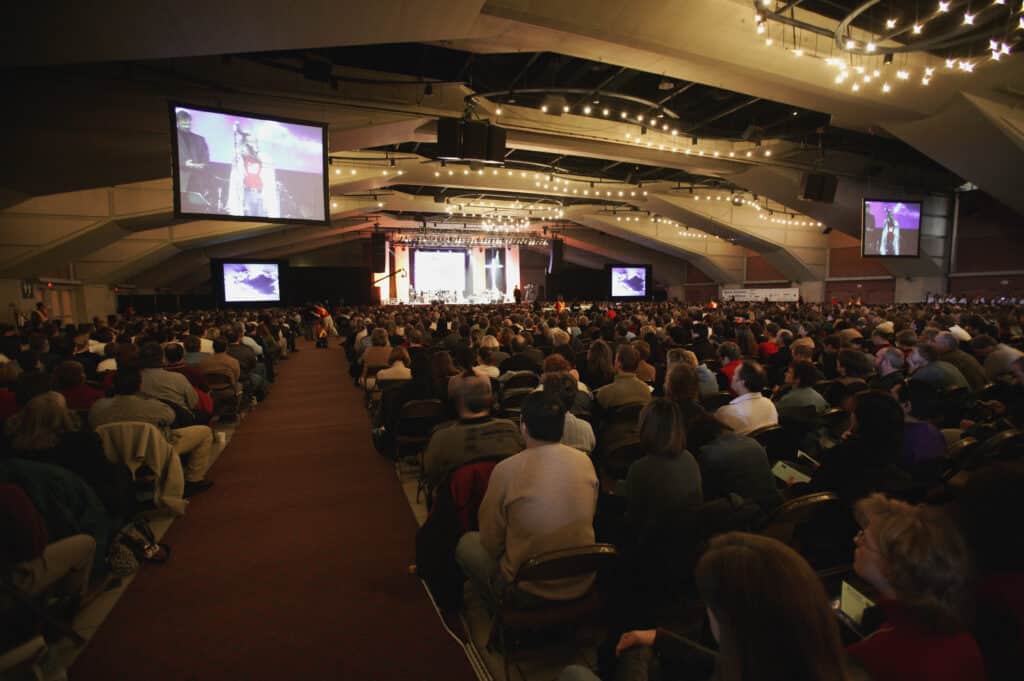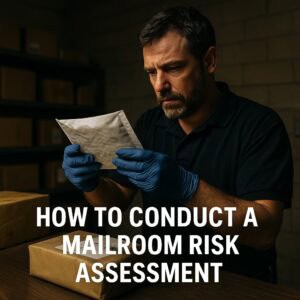A well-crafted vision and mission statement play an essential role in the successful operation of a church security team.
Developing a clear and impactful vision and mission statement can help guide the team’s goals and objectives, ultimately, ensuring the church remains a safe and welcoming environment for all members, staff, and visitors.
To create an effective vision and mission statement for a church security team, it is crucial to understand the unique needs of the congregation, incorporate biblical values, and involve the church’s leadership in shaping and aligning these statements with the church’s culture.
Implementing vision and mission statements tailored to the security team’s purpose can assist in effectively communicating their goals and responsibilities.
In addition, this can play a critical part in rallying the church community around the shared goal of ensuring everyone’s safety and security.
It is also important to continuously review and refine the vision and mission statements to adapt to changing circumstances and maintain relevance and motivation.
Key Takeaways
- Crafting an effective vision and mission statement helps guide church security teams’ goals and objectives
- Incorporating biblical values and aligning statements with the church’s culture increases their effectiveness and impact
- Regularly reviewing and refining vision and mission statements is crucial for maintaining relevance and motivation
Understanding the Need for a Church Security Team
The need for a church security team has become increasingly evident in recent years.
As places of worship, churches serve as safe havens and gathering spaces for their congregations and the wider community.
This makes it crucial to maintain a secure and peaceful environment.
One reason for establishing a church security team is to protect the congregation from potential threats such as theft, violence, or unauthorized access.
Church security teams are comprised of unarmed individuals trained in safety measures, security lockdowns, and responses to various emergency situations.
By adding this layer of protection, a church can proactively address possible risks and provide a safe environment for those within its walls.
Another essential aspect of a church security team is its role in managing medical emergencies.
When incidents such as sudden illness or accidents occur, having security team members trained in first aid and emergency response can make a significant difference in ensuring prompt care and minimizing harm to those affected.
Furthermore, the presence of a dedicated security team helps to instill a sense of safety and comfort for both church members and visitors.
This can enhance the welcoming atmosphere that churches aim to provide, fostering a stronger sense of community.
Defining Vision and Mission Statements
Vision Statement
A vision statement outlines the desired future state that a church security team aims to achieve.
This statement should be aspirational and ambitious, serving as a motivational force for members, while also conveying the team’s ultimate purpose.
Vision statements often include broader goals related to ensuring safety and fostering a secure environment within the church community.
Mission Statement
On the other hand, a mission statement provides specific and actionable steps that the church security team will take in order to achieve the vision.
This statement should be clear and concise, outlining the team’s primary objectives and responsibilities.
It should also reflect the team’s core values, ensuring that all actions taken are in line with the guiding principles of the church security team.
Values Statement
When crafting these statements, it’s essential to define the team’s values statement as well.
This statement captures the core beliefs that uphold the team’s mission and vision, guiding decision-making and promoting accountability.
Some examples of values that might be important for a church security team include:
- Integrity
- Compassion
- Respect
- Teamwork
- Dedication
By clearly defining a vision, mission, and values statement, a church security team can set the foundation for success and create a sense of shared purpose among its members.
With these statements in place, the team will have a strong foundation for making decisions, setting priorities, and ensuring that the overall safety and well-being of the church community are upheld.
One vital aspect of crafting these statements is achieving clarity.
Avoid using abstract language that can lead to confusion or misinterpretation.
Instead, use specific and concrete terms that clearly convey the team’s objectives and values.
This clarity will help guide the team’s actions and ensure that all members are working towards a common goal.
Incorporating Biblical Values in Vision and Mission Statements
When crafting the vision and mission statements for a church security team, it’s essential to incorporate biblical values to reflect the core tenets of the faith.
This incorporation ensures that the security team’s actions and decisions align with the church’s overall mission, guided by the teachings of the Bible.
One key biblical value to consider is the Gospel, which serves as the foundation of a believer’s faith.
Including the Gospel in your statements emphasizes the church’s commitment to spreading the Good News and protecting the congregation as it fulfills the Great Commission (found in Matthew 28:19).
Other biblical values you may choose to incorporate in your vision and mission statements include love, fellowship, worship, and discipleship.
By fostering an environment of love, the security team can create a sense of belonging for everyone attending church services.
Fellowship and worship are essential aspects of the church community; promoting these values ensures that your security team’s goals are aligned with the congregation’s spiritual needs.
Building strong relationships within the security team and between the team and the congregation is vital.
The security team not only acts as a physical safeguard for the church but also as an embodiment of these core values.
By emphasizing the importance of relationships, the security team can create a cohesive group dynamic that enhances the effectiveness and trustworthiness of their function.
Crafting a Compelling Vision Statement for Your Church Security Team
A compelling vision statement serves as a guiding light for the church security team, motivating and empowering members to achieve their common goals.
It is crucial for the vision statement to be inspiring, memorable, and easy to understand so that it effectively communicates the team’s purpose to its members and the broader church community.
To create a compelling vision statement, it is essential to involve the entire team in the process.
By doing so, a sense of collective ownership is fostered, resulting in greater commitment and focus from the security team.
Start by hosting a brainstorming session with the team to gather ideas and identify the core values that drive them in their efforts to safeguard the church.
These core values might include safety, service, integrity, and vigilance.
Here are some steps to help craft the vision statement:
- Reflect on the church’s overarching vision and the role of the security team in achieving it.
- Identify the key values and principles that drive the team’s actions and goals.
- Establish a clear, tangible, and long-term desired outcome that the team aims to achieve.
- Ensure the statement is simple yet engaging, leading to increased hope and empowerment for the team.
For instance, the vision statement might be: “To create a safe and secure environment for worship and fellowship by fostering a culture of vigilance, integrity, and service.”
This statement is simple, communicates the main goals of the security team, and aligns with the overarching vision of the church.
Once the vision statement has been finalized, make sure it is effectively communicated to all members of the security team.
This can be achieved through team meetings, training sessions, and even posters or banners placed in the team’s workspace.
By continuously reinforcing the vision statement, the security team will remain inspired, focused, and empowered to carry out their important role within the church community.
Creating a Motivating Mission Statement for Your Church Security Team
A well-crafted mission statement lays the foundation for your church security team’s identity and actions.
It serves as a guiding principle, driving the team towards a clear purpose.
To create a motivating mission statement for your church security team, it should be actionable, focused on service excellence, and aligned with the church’s overall mission.
Begin by identifying the core values that will guide your team in their pursuit of safety and security.
These values should be rooted in the teachings of your church and a desire to create a positive impact on the congregation.
For example, your team’s values might include integrity, vigilance, and humility.
It is crucial that these values are shared by all team members, as they will define the team’s culture and approach to their duties.
Next, craft a concise, yet powerful mission statement that captures the essence of your team’s actions.
Effective mission statements are easy to understand and provide a clear direction for your team’s objectives.
For example, your church security team’s mission statement might be: “To glorify God by safeguarding our church community with excellence, vigilance, and compassion.”
This statement conveys a sense of purpose, asserting that the team’s primary goal is to protect the congregation and honor their faith.
In order to ensure that your mission statement is actionable, break it down into specific tasks or objectives.
Create a list of tasks that your team can use as a roadmap to achieve the desired outcomes stated in your mission statement.
For example:
- Train team members in security best practices and emergency response procedures
- Regularly assess and address potential security risks and vulnerabilities
- Foster open communication and collaboration within the team and with the church leadership
Remember to keep the mission statement focused on how your team can serve and support the broader goals of your church.
Aligning your security team’s objectives with the church’s mission will lead to a more cohesive and effective organization.
By taking the time to develop a focused, actionable, and service-oriented mission statement, your church security team will have a clear understanding of their purpose and the impact they can make.
Role of Leadership in Shaping Vision and Mission Statements
The leadership in a church security team plays a crucial role in shaping the vision and mission statements.
A senior pastor and other key stakeholders need to be involved in the process of crafting these statements to ensure their effectiveness and alignment with the overall goals and values of the church.
One key element is the ability of the leadership to facilitate decision-making within the team.
A church security team’s leadership should guide members in identifying the team’s primary objectives and the strategies needed to achieve them.
These objectives should be tied to the broader vision and mission statement.
This can be done through the use of strategy workshops, brainstorming sessions, and other collaborative activities that engage the team members.
Communication plays a vital role in this process.
It is essential for the leadership to consistently communicate the vision and mission statements to the team members and the congregation as a whole.
This helps ensure that everyone understands and supports the team’s purpose and goals.
It also creates a sense of ownership and accountability among the team members, strengthening their commitment to the mission.
The leadership should also ensure that the vision and mission statements are:
- Relevant to the church’s overall goals and objectives
- Clear and easy to understand for all team members and the congregation
- Inclusive of the roles and responsibilities of the security team members
- Actionable and tied to specific strategies and tasks
By considering these factors, the leadership will create vision and mission statements that serve as a strong foundation for the church security team’s efforts and successes.
Aligning Vision and Mission Statements with Church Culture

When crafting a vision and mission statement for your church security team, it is crucial to ensure that these statements align with the overall culture of the church.
The culture of a church encompasses its values, beliefs, worship, discipleship, environment, and community interactions.
First, consider the values that form the foundation of your church.
These values may include love, faith, hope, and service.
The mission statement should reflect these values in the context of security.
For example, promoting a safe space that adheres to the principles of love and service.
Next, focus on how the security team contributes to the worship experience.
The vision and mission should emphasize that the team supports a distraction-free and peaceful environment, allowing members to fully engage in their spiritual journey.
Discipleship is another key element of church culture.
The security team’s mission should reflect this by ensuring that they are spiritually mature and growing in their faith.
This can be achieved through regular training, mentorship, and participating in small group studies.
The environment within the church is essential in shaping the overall church culture.
The vision and mission statements should be crafted in a way that highlights the importance of creating a welcoming atmosphere for everyone, regardless of their background or beliefs.
This involves addressing potential risks, fostering a sense of community and safety, and promoting inclusivity.
Finally, consider the overall beliefs of your church.
It is important for the security team’s vision and mission to align with the church’s doctrine and theology.
This includes recognizing the importance of prayer, scripture, and spiritual authority when making decisions and implementing security measures.
Communication and Implementation of Vision and Mission Statements
When introducing a vision and mission statement for your church security team, the communication and implementation process is crucial for setting the right tone and ensuring team members are aligned.
Proper communication ensures that the team understands the overall goals and objectives while successful implementation guarantees that the team operates effectively under the guidelines set forth by the statements.
Good communication is essential to get everyone on board with the church security team’s mission and vision.
Church leaders and security team management should present the statements in clear and concise language to all team members, using various methods such as newsletters and face-to-face meetings.
Make sure that communication is open and transparent, and encourage questions to help clarify any uncertainties.
Once the statements are well-communicated, it’s time for implementation.
Start by breaking down the steps necessary to implement the vision and mission, then develop a practical plan to achieve the goals.
Training sessions should be organized and tailored to the unique needs of your church security team, with a focus on educating team members on the specific guidelines and expectations outlined in the vision and mission statements.
This may include active shooter response, crisis management, or de-escalation tactics.
Some essential elements to consider while implementing the vision and mission statements:
- Training: Provide team members with the appropriate resources and tools to ensure they understand and adapt to the new guidelines.
- Expectations: Clearly communicate the standards and expectations for the team to ensure consistency and adherence to the objectives.
- Guidelines: Establish a set of well-defined guidelines that align with the church’s overall values, security goals, and mission.
- Accountability: Implement a system of accountability to help ensure that team members follow protocols and adhere to the set expectations.
Once the implementation process is complete, regular evaluation of the church security team’s performance is essential.
This promotes continued improvement and helps identify inconsistencies or issues that may arise.
Engage the team in self-assessments and provide constructive feedback to maintain a proactive and focused approach to church security.
Refinement and Review of Vision and Mission Statements
When crafting a vision and mission statement for your church security team, it is essential to continuously refine and review these statements to ensure their relevance as your team evolves.
Regular assessment of your vision and mission will help establish a clear, confident, and knowledgeable tone throughout your organization.
Team members should review and assess the current vision and mission statements together, discussing the strengths and weaknesses of each.
During this review process, focus on the following aspects to enhance their clarity:
- Achievability: Ensure your vision and mission are realistic and attainable, rather than unattainable aspirations that discourage your security team.
- Actionability: The statements should be clear and concise, using action-oriented language that inspires and motivates team members to fulfill their responsibilities.
- Adaptability: As your church security team grows and evolves, your vision and mission should gradually adapt to reflect the current needs and goals of the organization.
While refining your vision and mission statements, consider incorporating changes that support your church’s growth and development.
For example, updating the statements to emphasize a more proactive approach to safety concerns or improving communication within the team.
Continual refinement and review of your vision and mission statements not only enhance their effectiveness but also promote a strong and unified church security team.
Encourage open dialogue among team members, as this ensures that every perspective is included and will contribute to the statements’ ongoing evolution and success.
Monitoring your church security team’s progress toward achieving its vision and mission can be done through regular performance reviews and feedback sessions.
Frequently Asked Questions
What are the key components of a church security team’s mission statement?
A church security team’s mission statement should include its main goals and objectives. It should clearly convey the team’s commitment to creating a safe and secure environment for all church members, staff, and visitors while maintaining a welcoming atmosphere. The mission statement should also reflect the team’s values and role within the church community. For example, a mission statement might emphasize protecting members and promoting a sense of security.
How do you develop a clear vision for your church security team?
Developing a clear vision for your church security team involves considering the specific needs of your church community and identifying potential threats. It is essential to involve church leadership, members, and stakeholders in the vision development process. Evaluate the current security measures and identify areas for improvement. Use these insights to create a vision that articulates the desired outcomes and direction for the security team. The vision should be inspirational, guiding the security team’s actions and decisions.
What can we learn from successful churches that have implemented security teams?
Successful churches with security teams have embraced the importance of safety and preparedness. They have prioritized clear policies and procedures while maintaining a warm and welcoming environment. These churches have ensured effective communication among security team members and fostered collaboration between the team and the larger church community. They have also been proactive in staying updated on security best practices and adapted their strategies as needed.
What role does the church leadership play in the formation of a security team?
Church leadership plays a critical role in the formation of a security team. Leaders should be involved in setting the vision and mission statement, ensuring that the security team is aligned with the church’s overall objectives. They should also be responsible for providing necessary resources, such as training, equipment, and financial support. Furthermore, church leaders should communicate the importance of safety and security to the congregation and promote a culture of vigilance and preparedness.
How do we ensure that the security team’s mission aligns with the overall church goals?
To ensure alignment between the security team’s mission and the overall church goals, it is crucial to involve church leadership in the development of the mission statement. Clear communication between the security team and leadership can help ensure that both parties understand the importance of security in achieving the church’s objectives. Regular evaluations and feedback should be conducted to assess the security team’s progress and make any necessary adjustments.
What best practices should be considered when creating a vision and mission statement for church security?
When creating a vision and mission statement for church security, consider the following best practices:
- Involve church leadership, security team members, and other stakeholders to ensure a comprehensive and accurate understanding of the church’s security needs.
- Clearly articulate the security team’s goals, values, and role within the church community.
- Focus on creating a safe, secure, and welcoming environment.
- Incorporate best practices and lessons learned from successful churches with security teams.
- Ensure that the vision and mission statement are consistent with the overall church goals and values.
- Regularly review and update the vision and mission statement as needed to reflect changes in the church community or security environment.








